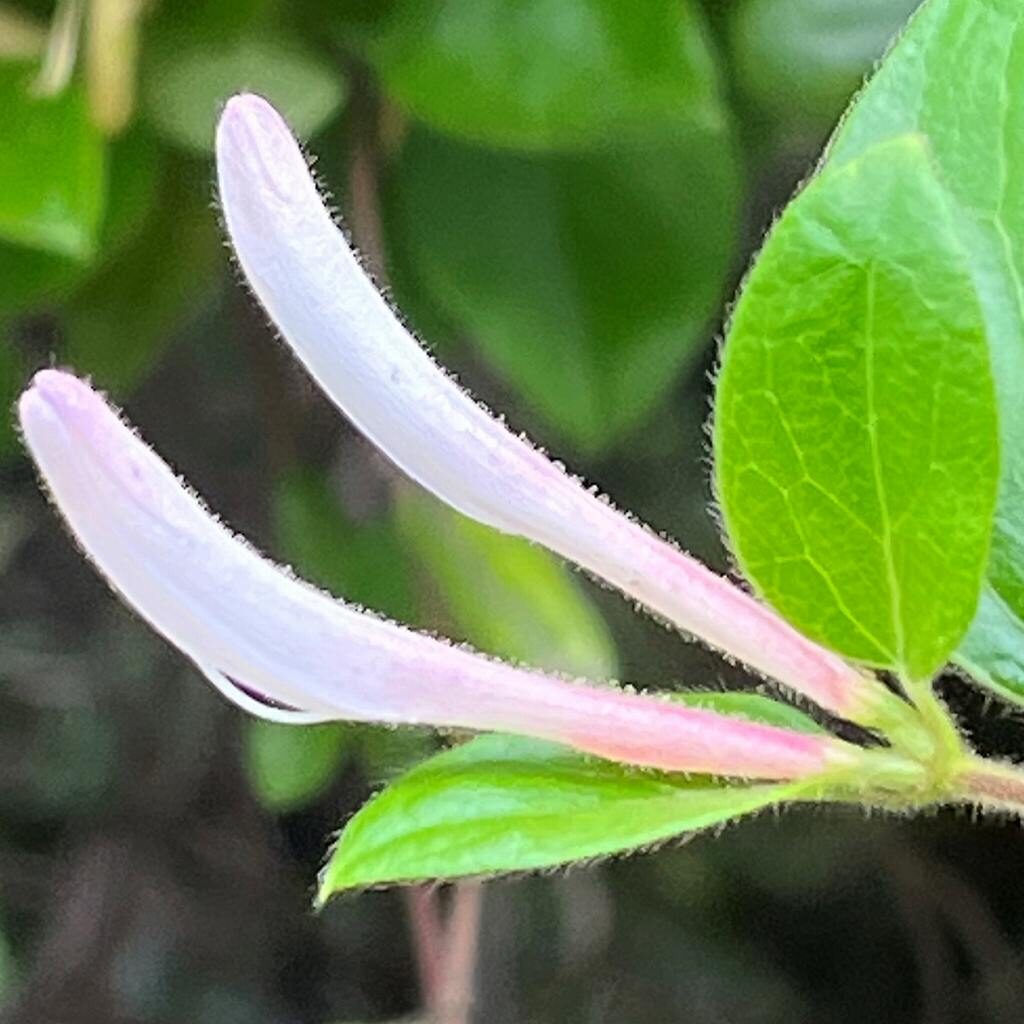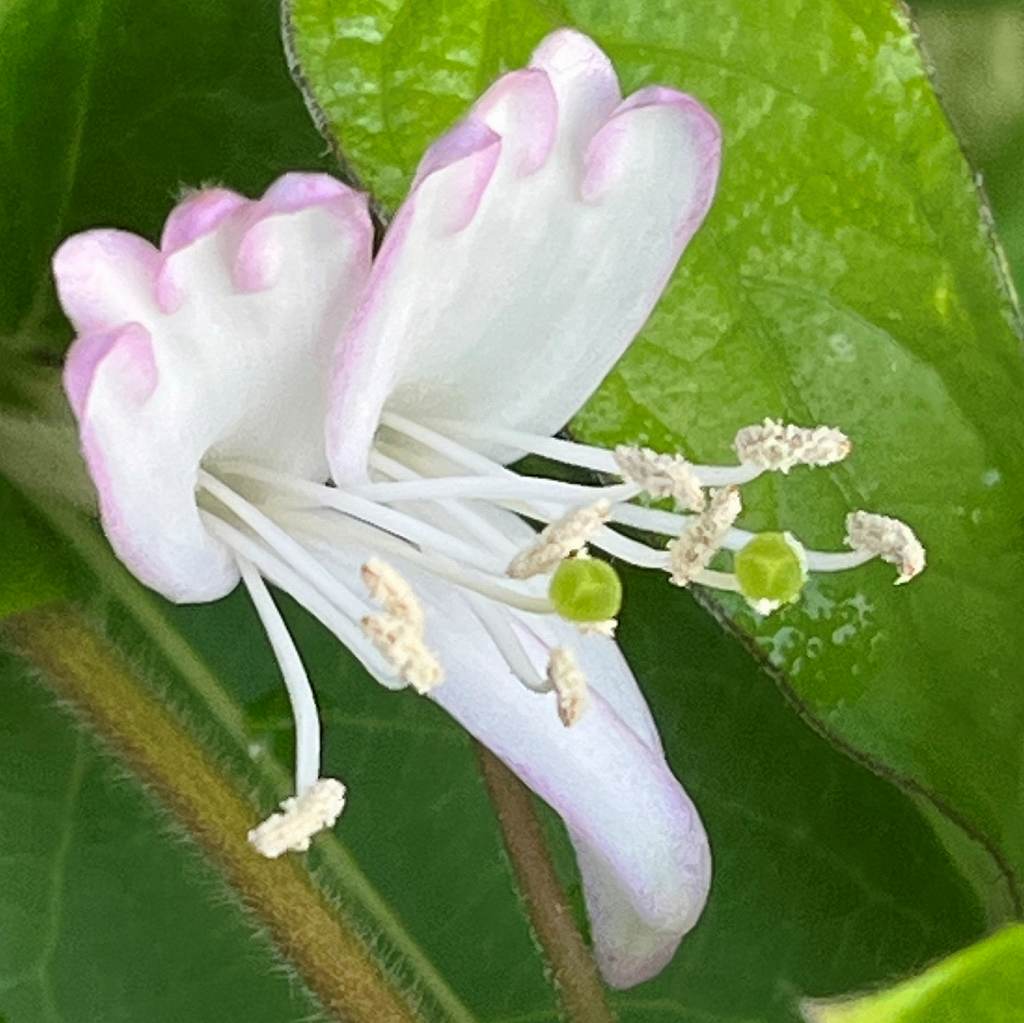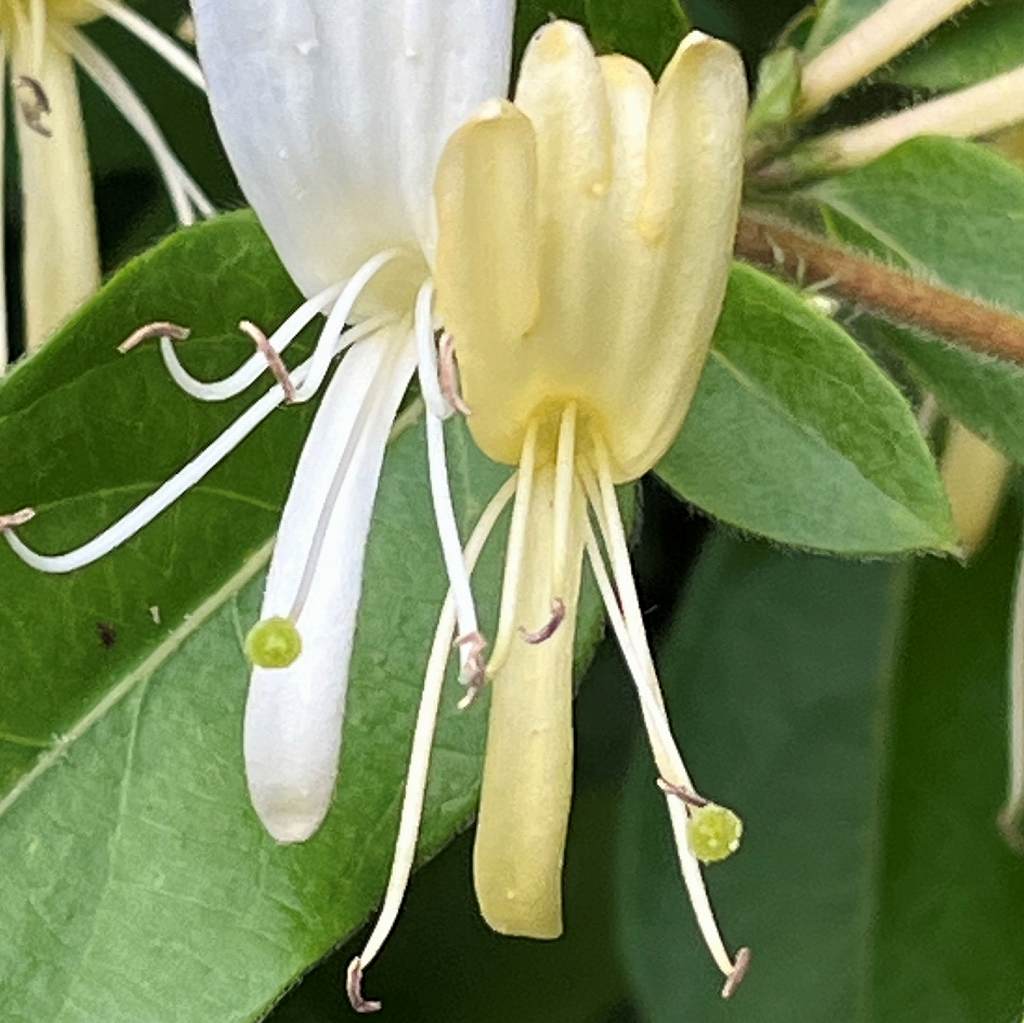スイカズラの花は枝先に2つずつ咲きます。蕾は薄紅、花は咲き始めが白色、咲き終わりが黄色。芳香があり、夕方から甘い匂いが漂います。
Japanese honeysuckle bloom two flowers at the tip of branch. The buds are light red, the flowers are white at the beginning of bloom, and yellow at the end of bloom. It is fragrant and has a sweet scent from the evening.
【仮名】スイカズラ, ニンドウ, キンギンカ
【和名】吸葛, 忍冬, 金銀花
【英名】Japanese Honeysuckle, Honeysuckle
【学名】Lonicera japonica
【誕生】05/ 29, 06/ 03, 06/ 17, 06/ 22, 06/ 30
【開花】05, 06月
【花色】White, Yellow



スイカズラ
スイカズラの生態
スイカズラはスイカズラ科の蔓性常緑樹です。日本では北海道南部から九州まで、国外では朝鮮半島や台湾、中国などに分布。林縁や道端などに自生しています。19世紀に欧米へ渡り、観賞用で栽培されるものの、広く野生化して森林を覆うなどして問題に。花言葉は「愛の絆」です。
スイカズラの名前
スイカズラの名前の由来は甘味に乏しい昔、子どもたちが花を採って口にくわえ、花蜜を吸って遊んだため。英名も「蜜を吸う」という意味です。別名「忍冬」は冬でも一部の葉が散らないで耐え忍び、枯れずに残るから。「金銀花」は花色が白(銀)から黄(金)に変わるからです。
スイカズラの葉
スイカズラの蔓は分岐しながら長く伸び、穏やかに繁茂しながら他の植物に絡みつきます。葉は対生で、季節とともに形が変化。春の若葉は縁が波打ち、夏から秋の成葉は縁が丸みを帯び、冬は厚みを増して少し裏側に巻き、一部が枝先に残って春まで。蔓も葉も毛が密生しています。
スイカズラの花
スイカズラの花は枝先に2つずつ咲きます。蕾は薄紅色、花は咲き始めが白色、咲き終わりが黄色。花弁は4枚が掌のように合わさって上に反り、1枚が舌を出すように前に伸びます。雄しべは5本、雌しべは柱頭が丸い緑色。花筒の奥に花蜜があります。果実は丸く、熟すと黒色に。
スイカズラの利用
スイカズラは庭園や垣根など観賞用に植栽。花は芳香があり、夕方から甘い匂いが漂います。春夏の蕾は「金銀花」、秋冬の茎葉は「忍冬」という生薬に。利尿、健胃、解熱、浄血作用があるとされます。新芽や若葉はお浸しや和え物などに、葉は干して煎ってお茶に、花は酢の物に。
Japanese Honeysuckle
Ecology of Japanese honeysuckle
Japanese honeysuckle is a vine evergreen tree of the family Caprifoliaceae. It is distributed from southern Hokkaido to Kyushu in Japan, and to the Korean Peninsula, Taiwan, and China overseas. It grows naturally on forest edges and roadsides. They went to Europe and the United States in the 19th century and were cultivated for ornamental purposes, but they became widespread and became a problem because they covered forests. The flower language is “bond of love”.
Name of Japanese honeysuckle
The origin of the name of Japanese honeysuckle is that in the old days when the sweetness was poor, children picked flowers, put them in their mouths, and smoked nectar. The English name also means “suck honey”. The reason why the other name is “Nindou: endure winter” is that even in winter, some leaves do not scatter and endure, and remain without dying. The reason for “Kinginka: gold and silver flowers” is that the flower color changes from white (silver) to yellow (gold).
Japanese honeysuckle leaves
The vines of Japanese honeysuckle grow long while branching, and grow gently and entangle with other plants. The leaves are opposite and change shape with the seasons. The edges of young spring leaves are rippling, adult leaves from summer to autumn have rounded edges, and the leaves in winter are thickened and wrapped a little on the back side, and some of them remain on the tip of the branch until spring. The vines and leaves are densely haired.
Japanese honeysuckle flower
Japanese honeysuckle bloom two flowers at the tip of branch. The buds are light red, the flowers are white at the beginning of bloom, and yellow at the end of bloom. Four petals fit together like a palm and bend upward, and one extends forward so that the tongue sticks out. There are 5 male stamens, and the female stamen is green with a round stigma. There is nectar in the back of the flower tube. The fruits are round and turn black when ripe.
Use of Japanese honeysuckle
Japanese honeysuckle are planted for ornamental purposes such as gardens and fences. The flowers are fragrant and have a sweet scent from the evening. The buds in spring and summer are called “Kinginka” and the foliage in autumn and winter is called “Nindou.” It is said to have diuretic, healthy stomach, fever-relieving, and blood-purifying effects. Sprouts and young leaves can be used for soaking and seasoning, leaves can be dried and roasted for tea, and flowers can be used for vinegar.


